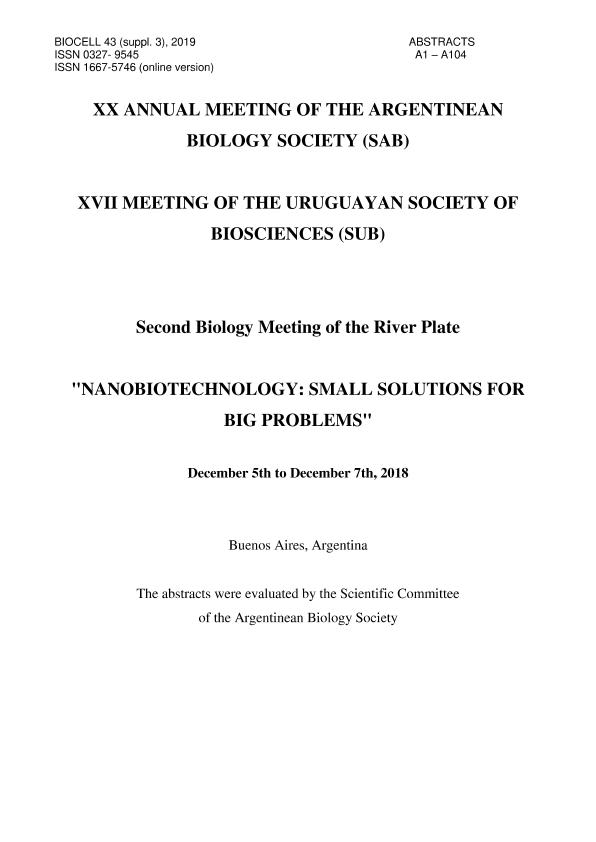Mostrar el registro sencillo del ítem
dc.contributor.author
Angelicola, María Virginia

dc.contributor.author
Viñarta, Silvana Carolina

dc.contributor.author
Aybar, Manuel Javier

dc.contributor.author
Castellanos, Lucia Ines

dc.date.available
2023-02-13T15:28:40Z
dc.date.issued
2018
dc.identifier.citation
Effect of glucose concentration on growth and fatty acids profile of two Rhodotorula glutinis strains; XX Jornadas Anuales de la Sociedad Argentina de Biología y XVII Jornadas de la Sociedad Uruguaya de Biociencias; Ciudad Autónoma de Buenos Aires; Argentina; 2018; 1-2
dc.identifier.uri
http://hdl.handle.net/11336/187759
dc.description.abstract
Certain oleaginous yeasts as Rhodotorula glutinis can accumulate neutral lipids up to 70% of dry biomass, consisting mainly in triacylglycerols (TAG), under appropriate culture conditions. Microbial TAG represent a valuable alternative feedstock for biodiesel production. Lipid accumulation occurs under nutrient limitations, mainly nitrogen, with simultaneous excess of carbon source. The lipid synthesis and fatty acids (FA) composition are influenced by several factors as carbon source (type and concentration), aeration, growth, temperature, C/N ratio, pH, among others parameters.. Effect of initial glucose concentration (30, 40 and 100 g L-1) on growth, lipid synthesis and FA profile of two strains of R. glutinis (R4 and R48) isolated from Antarctica was investigated using a nitrogen-limited medium (MI). Yeasts were incubated aerobically on a rotatory shaker during 120 h at 250 rpm and 25 °C. Analytical determinations (biomass, lipid production, lipid content and residual glucose) were performed after 120 h of culture time. Glucose affected the growth of the strains and the FA profile of the microbial TAG. According to the results, the growth exhibited by R48 (12.33-13.83 g L-1) were higher than R4 (8.42-10.83 g L-1) for all glucose concentrations assayed. An increase of the lipid content (from 50.6 to 60.2%) and a decrease of the biomass were exhibited by R4 when the glucose concentration increased from 30 to 100 g L-1. However, significant differences on lipid accumulation and growth were not observed for R48. The FA profile of microbial lipids was analyzed by GC-FID (Viñarta et al. 2016). FA with chain length between 14 and 18 carbons dominated the lipidic profile of both strains. Eighteen-carbons FA were the most abundant (68.27-85.59%). The increase of glucose concentration affected the FA composition of the yeasts. Higher glucose concentrations caused an increase in the relative abundance of oleic and palmitic acids with a simultaneous decrease of linoleic and linolenic acids in in the FA content of R48 strain. Different effect of glucose concentration was observed in R4 and a decrease of oleic and linoleic acids with an increase of palmitic acid were observed at the highest glucose concentration. Results demonstrate that the FA profile of R. glutinis R4 and R. glutinis R48 are comparable with other oleaginous yeasts reported in the literature. The better FA composition as feedstock for biodiesel was observed by R4 with 30 g L-1 of glucose, whilst for R48, with 100 g L-1. The FA profile of R. glutinis R4, with a high content of oleic acid (~60%), is quite similar to vegetables oils, indicating that its lipids have potential as a feedstock for biodiesel production.
dc.format
application/pdf
dc.language.iso
eng
dc.publisher
Sociedad Argentina de Biología
dc.rights
info:eu-repo/semantics/openAccess
dc.rights.uri
https://creativecommons.org/licenses/by-nc-sa/2.5/ar/
dc.subject
OLEAGINOUS YEASTS
dc.subject
COLD ADAPTED YEASTS
dc.subject
BIODIESEL
dc.subject
SINGLE CELL OILS
dc.subject.classification
Bioprocesamiento Tecnológico, Biocatálisis, Fermentación

dc.subject.classification
Biotecnología Industrial

dc.subject.classification
INGENIERÍAS Y TECNOLOGÍAS

dc.title
Effect of glucose concentration on growth and fatty acids profile of two Rhodotorula glutinis strains
dc.type
info:eu-repo/semantics/publishedVersion
dc.type
info:eu-repo/semantics/conferenceObject
dc.type
info:ar-repo/semantics/documento de conferencia
dc.date.updated
2023-02-06T13:54:05Z
dc.journal.pagination
1-2
dc.journal.pais
Argentina

dc.journal.ciudad
Buenos Aires
dc.description.fil
Fil: Angelicola, María Virginia. Consejo Nacional de Investigaciones Científicas y Técnicas. Centro Científico Tecnológico Conicet - Tucumán. Planta Piloto de Procesos Industriales Microbiológicos; Argentina
dc.description.fil
Fil: Viñarta, Silvana Carolina. Consejo Nacional de Investigaciones Científicas y Técnicas. Centro Científico Tecnológico Conicet - Tucumán. Planta Piloto de Procesos Industriales Microbiológicos; Argentina
dc.description.fil
Fil: Aybar, Manuel Javier. Consejo Nacional de Investigaciones Científicas y Técnicas. Centro Científico Tecnológico Conicet - Tucumán. Instituto Superior de Investigaciones Biológicas. Universidad Nacional de Tucumán. Instituto Superior de Investigaciones Biológicas; Argentina
dc.description.fil
Fil: Castellanos, Lucia Ines. Consejo Nacional de Investigaciones Científicas y Técnicas. Centro Científico Tecnológico Conicet - Tucumán. Planta Piloto de Procesos Industriales Microbiológicos; Argentina
dc.relation.alternativeid
info:eu-repo/semantics/altIdentifier/url/https://www.biologia.org.ar/descargas/jornadas/Biocell-43-Suppl-3-2019_SAB-SUB-2018.pdf
dc.conicet.rol
Autor

dc.conicet.rol
Autor

dc.conicet.rol
Autor

dc.conicet.rol
Autor

dc.coverage
Internacional
dc.type.subtype
Jornada
dc.description.nombreEvento
XX Jornadas Anuales de la Sociedad Argentina de Biología y XVII Jornadas de la Sociedad Uruguaya de Biociencias
dc.date.evento
2018-12-05
dc.description.ciudadEvento
Ciudad Autónoma de Buenos Aires
dc.description.paisEvento
Argentina

dc.type.publicacion
Journal
dc.description.institucionOrganizadora
Sociedad Uruguaya de Biociencias
dc.description.institucionOrganizadora
Sociedad Argentina de Biología
dc.source.revista
Biocell

dc.date.eventoHasta
2018-12-07
dc.type
Jornada
Archivos asociados
